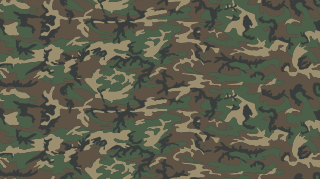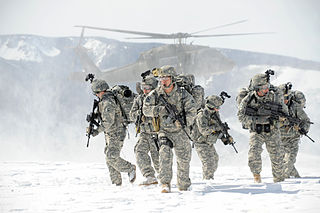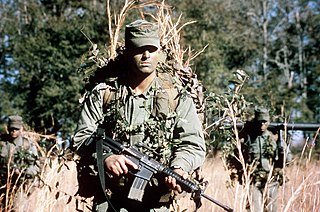 W
WThe Army Aircrew Combat Uniform (A2CU) is a two-piece flight suit in the universal camouflage pattern that offers the soldier protection from flash fires. The coat is similar to the ACU in design, with a stand-up collar featuring a front extension, shoulder patches, a front zipper, two inside hanging chest pockets with flaps; adjustable waist; two-piece set-in sleeves with elbow patches; two sleeve utility pockets with flaps and Identification Friend or Foe (IFF) tabs; and two lower sleeve pencil pockets with flaps. It can be worn with the Air Warrior Microclimate Cooling Vest. The trousers have nine pockets: two thigh pockets; two calf pockets with external tool pockets; one knife pocket with lanyard ; and two side hanging pockets. Pockets have flaps and zippers.
 W
WThe Army Combat Shirt (ACS) is a flame-resistant shirt developed and used by the United States Army as a supplementary addition to the Army Combat Uniform. The ACS is a stand-alone shirt designed specifically for use with Improved Outer Tactical Vest armor in warm and hot weather instead of the blouse. It is intended to greatly increase user comfort through the use of lightweight, moisture-wicking, and breathable fabrics. The ACS was created in conjunction with the USMC's Flame Resistant Organizational Gear (FROG). The ACS, in conjunction with the Fire Resistant ACU (FRACU) trousers, provides head-to-toe protection against burns.
 W
WThe Army Combat Uniform (ACU) is the current combat uniform worn by the United States Army, U.S. Air Force, and United States Space Force.
 W
WThe Army Elements Fleece (AEF) is a versatile, insulating layer that allows US Army aviation crews to adapt to varying mission requirements and environmental conditions.
 W
WThe Army Service Uniform (ASU) is a military uniform worn by United States Army personnel in situations where business dress is called for. It can be worn at most public and official functions as an analog for civilian business attire. In combat situations, the Army Combat Uniform is used.
 W
WThe Battle Dress Uniform (BDU) is a camouflaged combat uniform that was used by the United States Armed Forces as their standard combat uniform from the early 1980s to the mid-2000s. Since then, it has been replaced or supplanted in every branch of the U.S. Armed Forces.
 W
WA buffalo coat is a heavy winter garment made from the bison, which also commonly known as the "buffalo". In North America they descended from the simpler, sleeveless buffalo robes worn by the Indigenous peoples of North America prior to their partial replacement by capotes made of point blankets during the North American fur trade. Similar garments were also used across Eurasia prior to the gradual displacement and near-extinction of the European bison or wisent. Commercially produced coats with sleeves and buttons became popular with non-indigenous people during the early settlement period of the American West and the Canadian prairies. Their use mostly ended because of a rising conservationist movement intended to preserve the bison, which had been hunted to near-extinction in North America as well.
 W
WDesert Uniforms, Patches, and Insignia of the US Armed Forces is a comprehensive reference book that provides a detailed study of desert uniforms, patches, and insignia worn by the US Armed Forces in combat from Desert Storm, through Somalia and in the campaigns of Iraq and Afghanistan.
 W
WThe ERDL pattern, also known as the Leaf pattern, is a camouflage pattern developed by the United States Army at its Engineer Research & Development Laboratories (ERDL) in 1948. It was not used until the Vietnam War, when it was issued to elite reconnaissance and special operations units beginning early 1967.
 W
WThe Extended Climate Warfighter Clothing System, or Gen III ECWCS, is protective clothing created in the 1980s as an exclusively cold weather system by the United States Army Natick Soldier Research, Development and Engineering Center, Natick, Massachusetts, but has been radically redesigned to cover a broad range of combat climates. The first generation ECWCS consisted of parka and trousers plus 20 other individual clothing, handwear, headwear and footwear items which are used in various combinations to meet the cold weather environmental requirements of the US military. Now, the third generation, or Gen III ECWCS, has been developed to maintain adequate environmental protection in temperatures ranging between +40 and −60 Fahrenheit. Include the Modular Sleep System (MSS).
 W
WThe Extended Cold Weather Clothing System is a protective clothing system developed in the 1980s by the United States Army Natick Soldier Research, Development and Engineering Center, Natick, Massachusetts. The first generation ECWCS consisted of parka and trousers plus 20 other individual clothing, handwear, headwear and footwear items which are used in various combinations to meet the cold weather environmental requirements of the US military. The Gen III ECWCS is designed to maintain adequate environmental protection in temperatures ranging between -60 and +40 Fahrenheit
 W
WThe Flame Resistant Environmental Ensemble (FREE) is a multi-layered, versatile insulating garment that is adaptable to varying mission requirements and environmental conditions. The system consists of undergarments, a base layer, midweight underlayer, light weather outer layer, intermediate weather outer layer, and an extreme/wet weather parka. It also includes cold weather gloves, a rigger belt, and wool socks.
 W
WThe infantry blue cord is a United States military decoration worn over the right shoulder of all infantry-qualified U.S. Army soldiers. It is a fourragere in light blue, specifically PMS 5415, worn under the right shoulder and under the right epaulette of a U.S. Army infantry soldier's Class A dress blue uniform jacket or Class B shirt. The cord is composed of a series of alternating left and right half knots that are tied around a leader cord to form a "Solomon bar".
 W
WThe jeep cap, sometimes referred to as the jeep hat, originally the US Army issued Cap, Wool, Knit, M1941 is a knit cap with a short visor made mostly from knitted yarn, originally wool, but now typically acrylic. Also sometimes referred to as a "skull cap" due to its popularity with skateboarders, or a "Radar cap" due to the cap being made famous by the character Radar O'Reilly from the hit US TV sitcom M*A*S*H.
 W
WLeggings refer to several types of leg coverings. Modern usage from the 1960s has come to refer to elastic close-fitting garments worn over the legs typically by women, such as leg warmers or tights. Usage from the 18th century refers to men's wear, usually made of cloth or leather that is wrapped around the leg down to the ankle. In the 19th century, leggings usually referred to infants' leg clothing that were matched with a jacket, as well as leg-wrappings made of leather or wool and worn by soldiers and trappers. Leggings prominently returned to women's fashion in the 1960s, drawing from the form-fitting clothing of dancers. With the widespread adoption of the synthetic fibre Lycra and the rise in popularity of aerobics, leggings came to further prominence in the 1970s and '80s, and eventually made their way into streetwear. Leggings are a part of the late 2010s athleisure fashion trend of wearing activewear outside sporting activities and in casual settings, which became a contentious social norm in the United States.
 W
WThe M-1951 field jacket was a US Army four pocket jacket made of 9-ounce wind resistant, water repellent treated cotton sateen cloth in Olive Green Shade 107. It was redesignated as the M-1951 field coat in November 1956.
 W
WThe M-1965 field jacket is a straight front, cold weather, field coat made of water-repellent fabrics. Initially designed for the United States military under the MIL-C-43455 standard, it is now often worn by civilians as an ordinary item of clothing.
 W
WThe OG-107 was the basic work utility uniform (fatigues) of all branches of the United States Armed Forces from 1952 until its discontinuation in 1989. The designation came from the U.S. Army's coloring code "Olive Green 107" and "Olive Green 507", which were shades of dark green, the OG-107 being cotton and OG-507 polyester-cotton blend introduced in the early 1970s. Regardless of the fabric, the two shades were almost identical. The OG-107 was superseded by the Battle Dress Uniform (BDU) throughout the 1980s, and was also used by several other countries, including ones that received military aid from the United States.
 W
WA patrol hat, also known as a field cap, is a soft kepi with a stiff, rounded visor, and flat top, somewhat similar to a baseball cap, worn by the military personnel of some countries in the field when a combat helmet is not required.
 W
W"Pinks and greens" and "Army greens" are colloquial terms for the United States Army's officer winter service uniform of the early 20th century and the similarly patterned service uniform introduced in the early 21st century.
 W
WA shoulder sleeve insignia is an embroidered patch worn on some uniforms of the United States Army. It is used by major formations of the U.S. Army; each formation has a unique formation patch. The U.S. Army is unique among the U.S. Armed Forces in that all soldiers are required to wear the patch of their headquarters as part of their military uniforms.
 W
WIn the United States Army, "tabs" are small cloth and/or metal arches displaying a word or words signifying a special skill that are worn on U.S. Army uniforms. On the Army Combat Uniform, the tabs are worn above a unit's shoulder patch and are used to identify a unit's or a soldier's special skill(s) or are worn on shoulder patches as part of a unit's unique heritage. Individual tabs are also worn as small metal arches above or below medals or ribbons on the Army Service Uniform.
 W
WThe U.S. Army's M1943 uniform was a combat uniform manufactured in windproof cotton sateen cloth introduced in 1943 to replace a variety of other specialist uniforms and some inadequate garments, like the M1941 Field Jacket. It was used through the remainder of World War II and into the Korean War with modifications before being replaced by the OG-107 uniform beginning in 1952.
 W
WThe U.S. Army universal camouflage trials took place from 2002 to 2004 with the goal of creating a single pattern that would provide adequate concealment in all environments. Four different patterns in a total of 13 variations were tested during the evaluation: three woodland patterns, three desert, three urban, three desert/urban, and one multi-environment pattern. The Universal Camouflage Pattern (UCP) found on the Army Combat Uniform was eventually adopted despite not having been part of the test.
 W
WThe woodland pattern is a camouflage pattern that was used as the default camouflage pattern issued to the United States Armed Forces from 1981, with the issue of the Battle Dress Uniform, until its replacement in the mid 2000s. It is a four color, high contrast disruptive pattern with irregular markings in sand, brown, green and black. It is also known unofficially by its colloquial moniker of "M81", though this term was not officially used by the U.S. military.